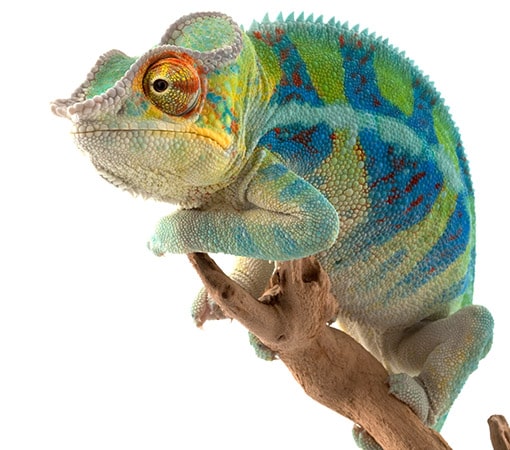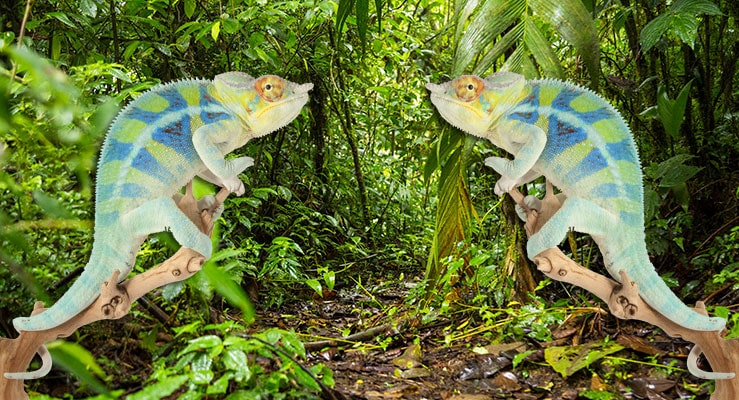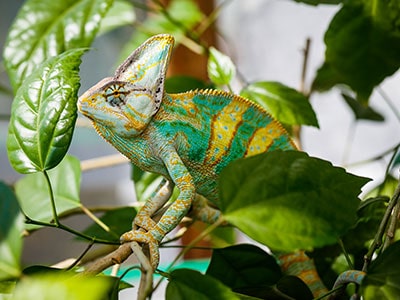Do you own an Ambanja Panther Chameleon or are interested in getting one and want to find more information about it?
You are in the right place since we are going to talk about why Ambanja Panther Chameleon is so fabulous, which are this chameleon's particularities, special requirements, and how to take care of this special pet.
Name & Origins
Ambanja Panther Chameleon originates from the tropical forests in the eastern and northern parts of Madagascar and is a sub-species of the Panther Chameleons (scientifically known as Furcifer pardalis).
The name "Ambanja" comes from the name of the district of Ambanja, the region where these chameleons are found.
In their natural habitat, the Panther Chameleons can be observed within the cocoa and coffee tree plantations, outside the populated zones of the city of Ambanja.
Colors & Particularities

What makes the Panther Chameleons in great demand is their varied and beautiful colors. The Ambanja Panther Chameleons do not make an exception and have some of the most remarkable colors.
Just like any species of Chameleon, the male specimens of the Ambanja Panther will get the most beautiful colorations.
While the most common color of their bodies is turquoise-green or blueish-turquoise, with either red or blue barring, they can also display yellow and orange. Their eyelids are typically orange or blue with radiation patterns.
Ambanja Panther Chameleons are sometimes easily mistaken with Ambato, another species of panther chameleons from an area in Northwest Madagascar, near Ambanja. They look pretty similar, but there are several key differences between these two varieties.
Someone has explained in detail the differences between Ambanja and Ambato on Chameleon Forums including some great photos. Thus, you can check it out if you are particularly interested in this topic.
Ambanja Panther Chameleon Lifespan
The lifespan of an Ambanja Panther Chameleon is around 5 to 7 years in captivity if it receives the proper care and only 1 to 3 years in its natural habitat due to numerous diseases, parasites, and natural predators. As pets, in very rare cases, they can even live up to 8 years.
These numbers vary greatly based on the level of care they receive. Usually, in captivity, males live longer since many females are heavily used for reproduction.
Requirements
For an Ambanja Panther Chameleon to thrive in captivity, it needs conditions close to its natural habitat. Since it originates from Madagascar's tropical forest biome, it requires conditions close to a tropical rainforest climate.
The good news is that most of the Panther Chameleons need very similar conditions. Thus, if you already own a Panther Chameleon from another part of Madagascar, you already know how to care for an Ambanja Panther Chameleon.
If this is your first pet chameleon or you are just in the "research" phase, keep reading.
Enclosure Size
Ambanja Chameleons are not the smallest varieties of chameleons. Same as any Panther chameleon, Ambanja can grow pretty large in captivity.
A male can reach between 38 to 53 cm (14-20 inches) and a female between 23 to 33 cm (9-13 inches).
If your chameleon is still very young, also take into account that he might be still into the growing phase and choose an enclosure that will also be large enough for him even when he gets bigger. You can start with a smaller enclosure, but getting a larger one from the beginning will help you save money in the future.
- For an adult male Panther chameleon, it's recommended to get at least a 24x24x48 inches enclosure.
- For an adult female Panther chameleon, you can get a 18x18x36 inches enclosure.
As for the enclosure types, the open-air screen cages are the best for any chameleons since they permit better ventilation.
Temperature
Because the Ambanja Panther Chameleon originates from the tropical rainforest of Madagascar, in captivity, it needs a heat lamp to keep a constant heated temperature in the enclosure.
According to Reptile Centre's panther chameleon care sheet, panther chameleons need a warm area of 90°F (33°C) in about 1/3 of the enclosure and 70°F (21°C) in the rest of the cage 10-12 hours in a day. That will allow the chameleon to get enough heat, but to also have an area where to cool down.
UVB Light
Chameleons are diurnal animals, which means they are active throughout the day and sleep at night (usually 12 hours or more).
In captivity, since they don't have access to natural sunlight, Ambanja chameleons, as well as other variety of chameleons need a source of UV light.
Naturally, the sun releases three different types of Ultraviolet radiations:
- UVA
- UVB
- UVC
Your reptile will mainly require UVA and UVB to stay healthy.
The UVA radiations regulate your pet's diurnal activity, feeding behaviors, mating, and other actions.
The exposure to the UVB radiations helps the chameleon to produce vitamin D3 synthesis, which enables them to absorb calcium from their food.
Chameleons require higher amounts of UVB light in particular.
All of the lights should be turned off at night to imitate the day-night cycle.
Diet
Ambanja Panther Chameleon doesn't have a special diet. Just like any panther chameleon, Ambanja chameleons are insectivores and have a diet based on crickets, roaches, silkworms, stick bugs, superworms, hornworms, and so on.
Ambanja Panther Price
Usually, the price of an Ambanja Panther chameleon will vary depending on age, gender, coloration, and from one breeder to another. Since they are rarer than other panther chameleon varieties, sometimes it may be harder to find and slightly more expensive.
The price range of an Ambanja Panther Chameleon is somewhere between $250-$500.
Final Word
Ambanja Panther Chameleons are one of the chameleon species commonly kept in captivity as pets. This variety is not as popular as other panther chameleon species such as Ambilobe, Nosy Be, Sambava, Nosy Faley, or Tamatave.
If this is your first chameleon pet, maybe you should start with a more common and less expensive breed such as a Veiled Chameleon. They are recommended by many to be more suitable for beginner chameleon owners due to their adaptability and more affordable price.


